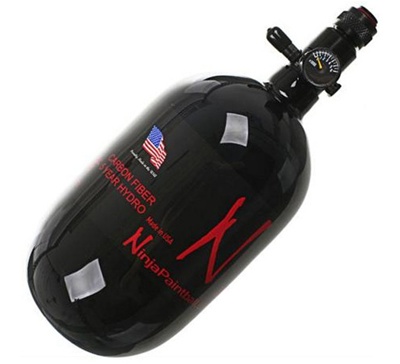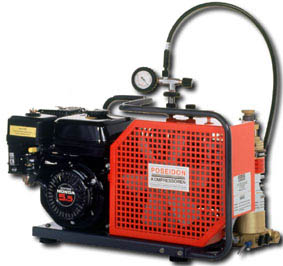Paintball can be a lot of fun, especially if you own a paintball compressor to fill up the tanks yourself.
I played paintball once last year and it really shows the power of compressed air (I think 'pain-ball, without the 't' would be a better name ;) The pain-balls leave the gun with a speed of about 100 meters per second (300 feet/second that is)!
While traditionally compressed gas like CO2 or Nitrogen was used, it becomes more and more popular to use ' home-made' compressed air with a high-pressure paintball compressor. In the long run, this is a lot cheaper than buying filled compressed gas tanks, and it will make you completely self-sufficient.
 Paintball compressed air tank with pressure regulator
Paintball compressed air tank with pressure regulator
The high pressure is needed because the air cylinder on the gun is relatively small; you will run out of air quickly if you use a lower pressure. You don't want to refill it every 5 minutes.
The high pressure in the storage cylinder is regulated back to anything between 250 and 850 psi. As the pressure in the high-pressure storage cylinder drops, the regulated output will stay the same (250 to 850 psi).
This is important, otherwise with every shot, your firing pressure would become lower.
Equipment needed to make compressed air for paintball
A typical setup to make compressed air for paintball guns consists of a high-pressure paintball compressor, one or more storage tanks and a fill station with two or more filling lines.
The compressor takes outside air and compresses it to about 310 bars / 4500 psi, which is a really high pressure. This means all the equipment used (like lines, storage cylinders etc.) must be rated for this high pressure. That's what makes it expensive.
The air-storage is usually just one or more high-pressure tanks. There is one line going from the compressor to the storage cylinders. There is another line going from the storage cylinders to the fill stations. The fill station is a box with a pressure regulator, pressure gauge and connections to connect the paintball gun cylinders to.
Paintball air compressor
The compressors used for paintball need to supply a very high pressure, which is why 99% of the paintball compressors are of the reciprocating piston type. Up to 4 stages are used most of the time.
 Typical paintball compressor 4 stages means that there are 4 cylinders/pistons that compress the air.
Typical paintball compressor 4 stages means that there are 4 cylinders/pistons that compress the air.
They do this in turn, so every piston compresses the air to a higher pressure. The compressor can be electrically power or can be power by a combustion engine.
Compressors that are sold as paintball compressors are usuallyt just scuba diving compressors, but without the filters to make breathing-quality air. That is not needed for paintball.
Unlike breathing-air used for diving (which is also high pressure), there are not many requirements for the air used in paintball. Water in the air can be an issue (there is always water generated when compressing air, see this page), but a compressed air dryer is hardly ever used. Instead, simple water drains are sued to drain the water from the air.
Size
When shopping for a paintball compressor, you will notice the big difference in price between units, mostly because of the size. So, what size is right for you?
There are two things to watch for: pressure and air-flow. The pressure needed is fixed. It's 4500 or 5000 psi, which is around 310 bars.
The other thing to look for is maximum air flow or capacity. This is the amount of air the compressor can compress per minute.
A very small and a very big compressor can both supply the same pressure: 4500 psi. But the big difference is air flow or capacity.
The big compressor can compressor much more air per minute compared to the small one. This means your storage cylinders are filled in less time.
So it depends on how fast you want to fill your tanks. You can buy a cheap, small air compressor and leave it running over night to fill up your storage cylinders. Or you buy an expensive, big compressor and fill them up in an hour.
Happy paintballing with your own paintball compressor!
Here are some recommended compressor sizes (all 310 bar / 4500 psi):
PlayersCompressed capacityNumber of storage cylinders0 - 10 plays per hourCompressor FAD (free air delivery) of 2 cfm (cubic foot per minute)Two storage cylinders10 - 20 plays per hourCompressor FAD (free air delivery) of 4 - 5 cfm (cubic foot per minute)Four storage cylinders20 to 50 plays per hourCompressor FAD (free air delivery) of 10 cfm (cubic foot per minute)Six storage cylinders50 to 100 plays per hourCompressor FAD (free air delivery) of 25 cfm (cubic foot per minute)Ten storage cylinders
